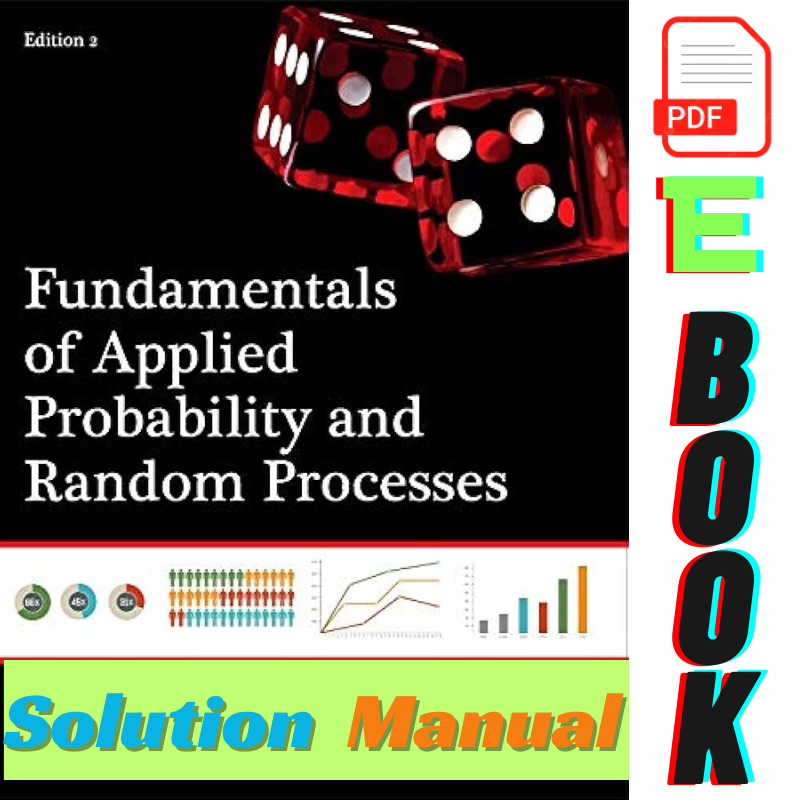Fundamentals of Applied Probability and Random Processes 2nd Edition Solution Manual
Probability theory and random processes serve as indispensable tools for engineers, enabling them to model and solve a wide array of real-world problems. The second edition of “Fundamentals of Applied Probability and Random Processes” presents a comprehensive overview of these concepts, building upon the success of its predecessor. Let’s delve into the key components that make this edition a valuable resource for both students and professionals in the field.
Introduction to Probability and Random Variables
Probability theory forms the cornerstone of this book, offering insights into the behavior of uncertain phenomena. Through clear explanations and illustrative examples, readers gain a solid understanding of probability fundamentals. Moreover, the concept of random variables is introduced, providing a framework for quantifying uncertainty in engineering applications.
Probability Distributions
The book delves into both discrete and continuous probability distributions, offering a comprehensive overview of their properties and applications. From the ubiquitous binomial and normal distributions to more specialized distributions like the Poisson and exponential, readers explore a diverse range of probability models essential for analyzing real-world data.
Conditional Probability and Independence
Conditional probability and independence play crucial roles in modeling complex systems. By elucidating these concepts, the book equips readers with the tools to analyze dependencies between events and make informed decisions in uncertain environments. Practical examples illustrate the relevance of conditional probability in engineering systems.
Expectation, Variance, and Moments
Expectation and variance serve as fundamental measures of central tendency and variability in probability distributions. The book provides clear explanations of these concepts, along with insights into higher-order moments. Understanding these statistical measures is essential for conducting rigorous engineering analysis and decision-making.
Functions of Random Variables
Transforming random variables enables engineers to model complex relationships and derive meaningful insights from data. The book explores various techniques for transforming random variables, highlighting their applications in signal processing, risk assessment, and other domains.
Introduction to Random Processes
Random processes are pervasive in engineering systems, making their understanding essential for engineers. The book introduces readers to the basics of random processes, including different types and their applications in communication systems, control theory, and more.
Markov Chains
Markov chains provide a powerful framework for modeling systems with sequential dependencies. The book covers the fundamentals of Markov chains, their properties, and practical applications in areas such as modeling and simulation.
NFPA 99 HEALTH CARE FACILITIES CODE 2024 Edition
Disruptive Statistics: A New Perspective
A standout feature of the second edition is the addition of a chapter on disruptive statistics. This chapter explores both descriptive and inferential statistics, offering a fresh perspective on their role in analyzing data and making informed decisions in engineering contexts.
Introduction to Stochastic Modeling
Stochastic modeling lies at the intersection of probability theory and real-world applications. The book introduces readers to the fundamentals of stochastic modeling, along with various techniques for modeling uncertainty in decision-making processes.
Statistical Inference
Statistical inference encompasses techniques for drawing conclusions from data, including hypothesis testing and confidence interval estimation. The book provides a thorough overview of these techniques and their practical applications in engineering and scientific research.
Estimation Theory
Estimation theory plays a vital role in parameter estimation and model fitting. The book covers both point and interval estimation techniques, along with Bayesian estimation methods that offer a principled approach to incorporating prior knowledge into the estimation process.
Regression Analysis
Regression analysis is a powerful tool for modeling relationships between variables and making predictions. The book covers linear and nonlinear regression techniques, along with practical considerations for building predictive models from data.
Time Series Analysis
Time series analysis is essential for understanding and forecasting sequential data. The book explores various time series components and forecasting techniques, with applications ranging from economic forecasting to environmental monitoring.
Queuing Theory
Queuing theory provides a framework for analyzing waiting lines and optimizing service systems. The book introduces readers to queuing models and their applications in diverse domains, including telecommunications, transportation, and healthcare.
Reliability Theory
Reliability theory focuses on the analysis and optimization of system reliability. The book covers key reliability metrics, models, and techniques for assessing and improving the reliability of engineering systems.
With its clear writing style, insightful examples, and comprehensive coverage of key topics, “Fundamentals of Applied Probability and Random Processes” is an invaluable resource for students and professionals alike. Whether used in the classroom or for self-study, this book provides a solid foundation in probability theory, stochastic processes, and statistical analysis, empowering readers to tackle real-world engineering problems with confidence.
FAQs
- Who is the target audience for “Fundamentals of Applied Probability and Random Processes”?
This book is primarily aimed at engineers and students studying probability, random processes, and statistics. However, anyone with an interest in understanding uncertainty and its applications in real-world problems can benefit from it.
- Does the second edition include any new chapters or significant updates compared to the first edition?
Yes, the second edition features new chapters on disruptive statistics and an introduction to random processes, along with additional illustrations and tables to enhance understanding.
- Are there practical exercises and homework problems included in the book?
Absolutely! The book includes a range of homework problems designed to reinforce key concepts and provide opportunities for hands-on learning.
- Can this book be used for self-study, or is it primarily intended for classroom use?
While it is suitable for classroom use, the clear writing style and comprehensive coverage make it well-suited for self-study as well.
- What makes this edition of “Fundamentals of Applied Probability and Random Processes” stand out from other textbooks on the subject?
This edition stands out due to its clear explanations, numerous illustrative examples, and practical focus on engineering applications, making complex concepts accessible and relevant to readers.

Reviews
There are no reviews yet.